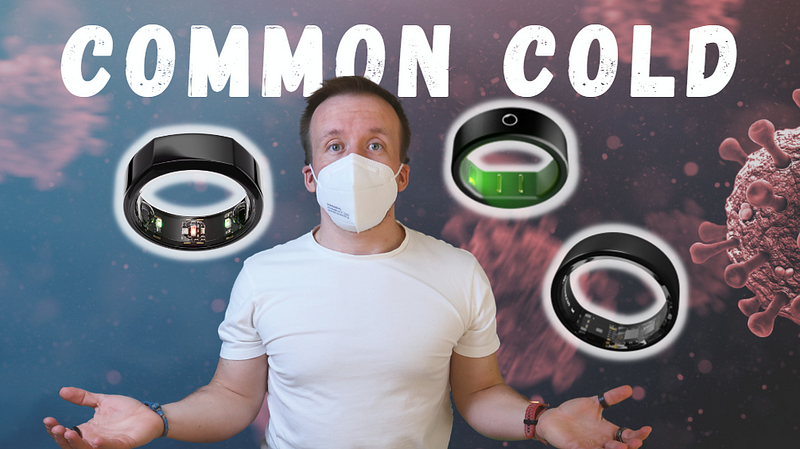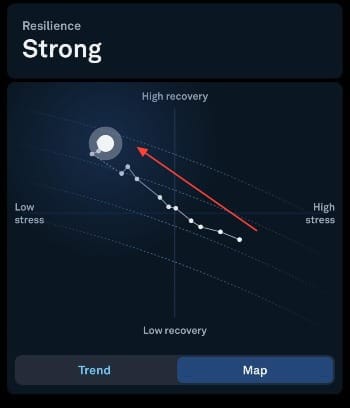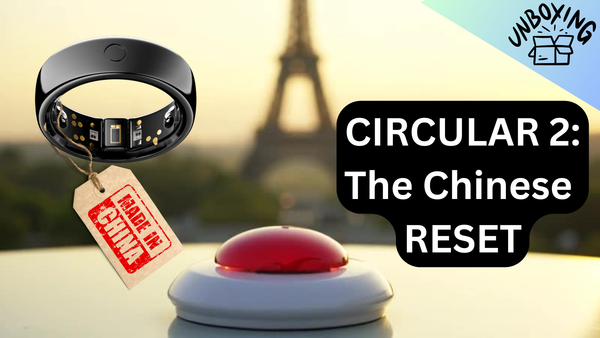How does Oura ring measure stress? And will it detect depression 😔?
In this post I will focus on two new features of the Oura Smart Ring and a recently published study. This is the Oura Daily Stress, Resilience (resilience) study on the link between body temperature and symptoms of depression.

In this post I will focus on two new features of the Oura Smart Ring and a recently published study.
This is a follow-up to my article on the "sick test" for using smart rings:

In that article I sang odes to the Oura ring in particular, and to one metric in particular that smart rings can measure - 🌡️ body temperature.
Body temperature, or deviation from baseline (average), has been key to early detection of disease, and is also a good indicator that the body has recovered from illness.
Now it turns out that temperature can also be a good indicator of other things - namely stress and depression.
Let's break it down step by step and briefly - if you don't need the theoretical sauce on the subject of "Stres➡️Deprese", don't unpack it 📜.
Stress 😓
Stress is defined as the physical and psychological response to perceived challenges, demands or threats in our environment. It is a natural part of life that can be triggered by various situations or events that are perceived as physically or emotionally.
- Acute stress - is temporary and can be motivating.
- Chronic stress - lasts for a longer period of time and can lead to health problems, including mental illness (such as DEPRESSION).
So what is depression? 🤯
Depression is a mental health condition characterised by persistent sadness, loss of interest or pleasure in usual activities, and various other symptoms that negatively affect a person's daily life. These symptoms may include fatigue, feelings of inferiority or guilt, sleep or appetite disturbances, difficulty concentrating, and thoughts of death or suicide.
Depression is usually diagnosed on the basis of a clinical assessment that includes a detailed interview and sometimes questionnaires or other screening tools.
What does smart💍OURA have to do with all this?
Oura has recently launched 2 interesting features that build on each other.
These are 📅 Daytime Stress and 🤯 Resilience.
📅 Daytime Stress
Daytime Stress is based on HR & HRV & Temperature (and therefore movement) measurements and the results are interpreted at 4 levels:

- Stressed - the highest level. According to Oura, it's common to reach this level (and it's OK), but it's also a sign to seek "restorative time", i.e. some form of mental rest, breathing exercises, etc.
- Engaged - a level of increased stress, but potentially good for productivity.
Relaxed - your body has moved from a state of stress to a state of mild recovery. - Restored- your body is recharging in a state of pure rest.
I've been going through a lot of posts on reddit where the authors all agree that this daily stress curve correlates with what happened during the day. Let's look at some examples.
Some examples
What's interesting is that "internal and external" influences, e.g. alcohol, illness, the Super Bowl final, etc., are intertwined with stress. Some of the examples are my own, others I have gathered from the community:

In the images above you can see that in addition to the 4 levels mentioned above, Oura also highlights the extreme levels with time in hours and minutes, i.e:
- Stressed - time spent in the Stressed level.
- Restored - also found in the app under Restorative time.
This daily stress functionality can be approached in two ways:
- Looking back at what the app measured, whether I was stressed and possibly why.
- Stressed that I was stressed 😄

Personally, I choose the path of review, validation (whether the readings make sense), awareness and reflection. It is the awareness, i.e. the retrospective awareness of moments that have stressed me in a negative way, that I find very useful.
Let me give you a trivial example. If you can see that you're constantly in stress mode at work, that's not going to be positive in the long run and it might be worth considering some changes - like focusing on that restorative time.
🤯Resilience
The Oura Resilience feature allows users to track their daily stress and recovery and monitor how this balance ⚖️ affects their stress resilience over time.
This feature is based on the idea that resilience can be built through healthy habits such as regular exercise, a healthy diet, adequate sleep and social support.
Oura has come full circle with this feature ⭕ as it reflects both day and night metrics. Specifically:
- the aforementioned daily stress
- Recovery time - i.e. the daily "rest and relaxation" time
- Night Recovery - which is a sleep metric calculated based on the Sleep Score and also accentuates the 2 most important sleep metrics, RHR, HRV. I also talked about these in this article:

Now, based on these three comprehensive contributors over the last 14 days, Oura puts together the overall picture in the form of a resilience "rating" on a scale:
LIMITED ▶️ ADEQUATE ▶️ SOLID ▶️ STRONG ▶️ EXCEPTIONAL
This rating is displayed in the form of two graphs:

So if you're wearing a third-generation Oura (and have a subscription), the graphs are constantly updated to reflect the new values. Each point is a new day. Below you can see how I went from the "bad" High Stress & Low Recovery quadrant to the "good" High Recovery & Low Stress quadrant in 14 days:

That was the description of Oura's current functionality, which Oura Health has no doubt been developing for several months. I'm going to take a proverbial step back and summarise it all in a very interesting study published in February 2024.
Study
This study, published in Scientific Reports, examined the association between body temperature and symptoms of depression using data collected from the Oura ring wearable device and participants' self-reported body temperature.
Key findings of the study
The study found that higher waking body temperature was associated with greater severity of depression symptoms. This relationship was observed for both self-reported body temperature and temperature measured by the Oura ring wearable device (second generation).
Conclusion
This study shows that monitoring body temperature can be a valuable tool for detecting and preventing depression. It is in line with the principles of Medicine 3.0, which aims to shift from treating acute problems to prevention, i.e. avoiding problems and diseases.
The study also highlights the importance of integrating wearable technology into healthcare. Such innovations are ushering in a new era where healthcare is more proactive, personalised and focused on maintaining good health rather than reacting to existing health problems.
In other words, wearable electronics are moving from the geek enthusiast level to the "I measure myself and get valuable data about my body and therefore my overall health" level.
I am now testing quite a few types and pieces of wearable electronics, especially smart rings. And there is still a need to take some data with a grain of salt, validate it and think critically about its benefits and real-life applications. There are a number of different metrics from different manufacturers that are mainly useful as a checkbox ✅ in a marketing brochure. But I think this is where Oura Health really shows its expertise and advantage.
Not just to praise Oura, RingConn, a cheaper alternative to Oura, also measures stress. And at first glance, we seem to agree:





